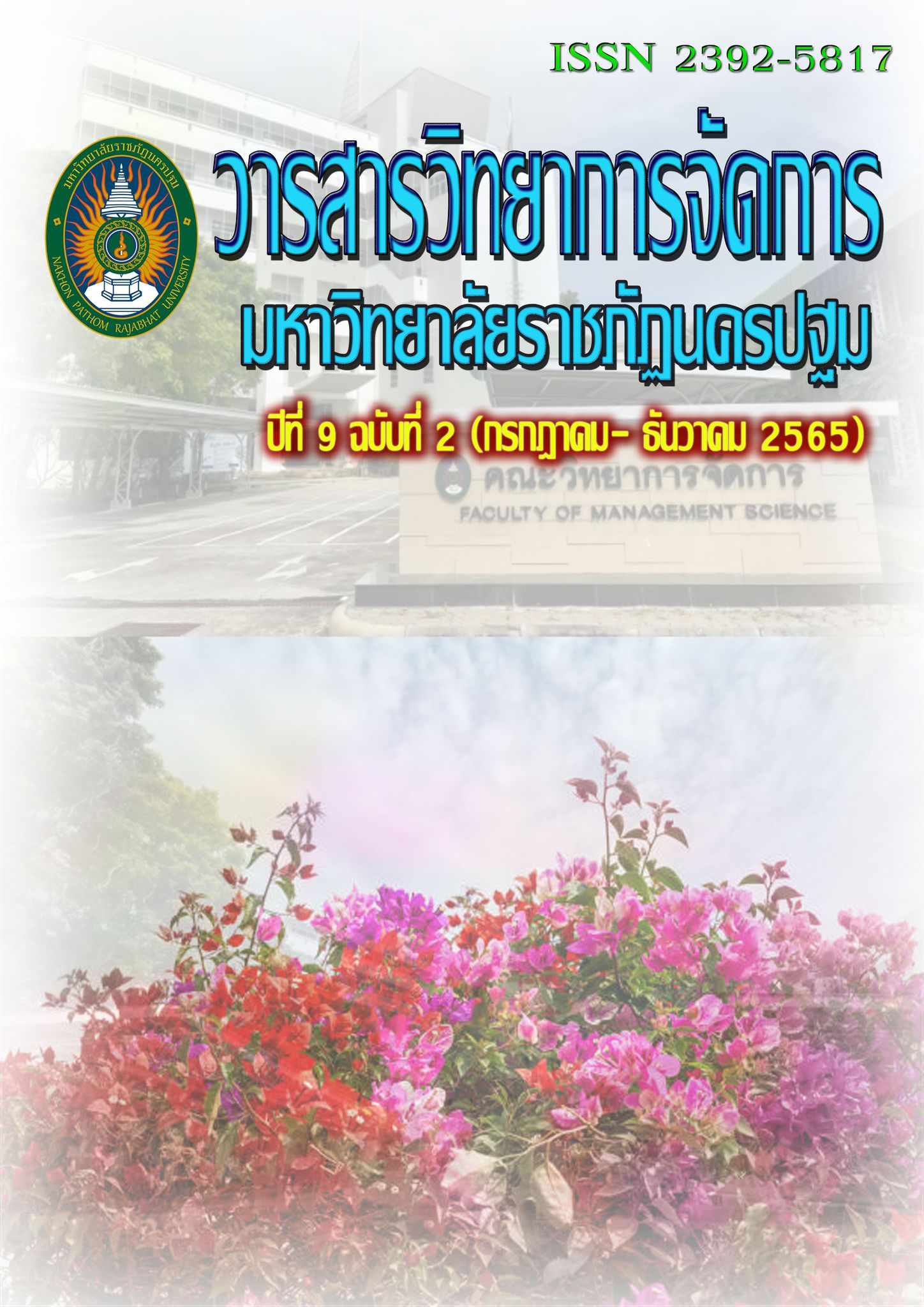ปัจจัยเชิงสาเหตุที่มีอิทธิพลต่อการเพิ่มขีดความสามารถทางการแข่งขัน ของธุรกิจโรงแรมขนาดกลาง ในประเทศไทย
Main Article Content
บทคัดย่อ
การวิจัยนี้มีวัตถุประสงค์ (1) เพื่อวิเคราะห์อิทธิพลของปัจจัยที่มีผลต่อการเปลี่ยนแปลงทางธุรกิจ ความสามารถทางการ แข่งขัน และผลการดําเนินงานของธุรกิจโรงแรมขนาดกลาง ในประเทศไทย (2) เพื่อสร้างรูปแบบความสัมพันธ์เชิงสาเหตุ เพื่อเพิ่มขีดความสามารถทางการแข่งขันไปสู่ธุรกิจโรงแรมขนาดกลาง ในประเทศไทย และ (3) เพื่อเป็นข้อเสนอแนะเพื่อเพิ่มขีดความสามารถทางการแข่งขันของธุรกิจโรงแรมขนาดกลาง ในประเทศไทย
การวิจัยนี้เป็นการวิจัยแบบผสมผสาน โดยการวิจัยเชิงปริมาณใช้วิธีการสุ่มตัวอย่างแบบแบ่งชั้นภูมิ จากประชากรจํานวน 4,570 ราย โดยกําหนดขนาดกลุ่มตัวอย่างตามเกณฑ์ของแฮร์ และคณะ ซึ่งกลุ่มตัวอย่างได้แก่ ผู้ประกอบการธุรกิจโรงแรมขนาดกลาง จํานวน 380 ราย และการวิจัยเชิงคุณภาพใช้วิธีการสุมแบบเจาะจง จํานวน 15 ท่าน ได้แก่ ผู้ประกอบการ และผู้เชี่ยวชาญ เครื่องมือที่ใช้ ในการเก็บรวบรวมข้อมูล คือ แบบสอบถาม สถิติที่ใช้ในการวิจัยครั้งนี้ คือ ค่าร้อยละ ค่าเฉลี่ย ค่าส่วน เองเบนมาตรฐาน และการวิเคราะห์โมเดลสมการโครงสร้างโดยโปรแกรมลิสเรล
ผลการวิจัย พบว่า ทรัพยากรพื้นฐาน ระบบควบคุมคุณภาพ และบทบาทภาครัฐ มีอิทธิพลต่อการเปลี่ยนแปลงทางธุรกิจโรงแรม ความสามารถทางการแข่งขัน และผลการดําเนินงานของธุรกิจโรงแรมขนาดกลาง การเปลี่ยนแปลงทางธุรกิจมีอิทธิพลต่อความสามารถทางการแข่งขัน และผลการดำเนินงานของธุรกิจโรงแรมขนาดกลาง มีอิทธิพลต่อการเพิ่มขีดความสามารถทางการแข่งขัน ข้อมูลเชิงประจักษ์โดยมีค่าดัชนีความกลมกลืนทั้ง 6 ดัชนีที่ผ่านเกณฑ์การยอมรับ คือค่าดัชนี 2/df = 1.214, CGI = 1.00, GFI = 0.98, AGFI 0.93, RMSEA = 0.026 และ SRMR = 0.012 ดังนั้น จึงสรุปได้ว่าแบบบจำลองสมการเชิงโครงสร้างมีความเหมาะสมและกลมกลืนกับข้อมูลเชิงประจักษ์
* หลักสูตรบริหารธุรกิจ มหาวิทยาลัยกรุงเทพธนบุรี กรุงเทพฯ 10170
Corresponding author: Phumayta@gmail.com
Article Details

อนุญาตภายใต้เงื่อนไข Creative Commons Attribution-NonCommercial-NoDerivatives 4.0 International License.
ทัศนะและข้อคิดเห็นของบทความที่ปรากฏในวารสารฉบับนี้เป็นของผู้เขียนแต่ละท่าน ไม่ถือว่าเป็นทัศนะและความรับผิดชอบของกองบรรณาธิการ
เอกสารอ้างอิง
มาลินี สนธิมูล และอิทธิกร ขำเดช. (2557). ความพึงพอใจของนักท่องเที่ยวชาวต่างชาติที่มีต่อการใช้บริการโรงแรมระดับ 5 ดาว ในเขตกรุงเทพมหานคร. วารสารการเงิน การลงทุนการตลาดและการบริหารธุรกิจ, 4(2),204-217.
ศุภลักษณ์ สุริยะ และเทิดชาย ช่วยบำรุง. (2556).แนวทางการพัฒนาคุณภาพการบริการของแผนกต้อนรับส่วนหน้าโรงแรมเพื่อรองรับนักท่องเที่ยวอาเซียน กรณีศึกษา: โรงแรมบูติก กรุงเทพมหานคร. Ph.D. In Social Sciences Journal, 3(1), 5–18
ศูนย์วิจัยเศรษฐกิจและธุรกิจ ธนาคารกรุงศรีอยุธยา (2564) ธุรกิจ/อุตสาหกรรม ปี 2562-2564: ธุรกิจโรงแรม [ออนไลน์]. ค้นเมื่อ 6 ธันวาคม 2564 จาก https://www.krungsri.com/th/research/industry/industry-outlook/Services/Hotels/IO/io-hotel-21
Almor, T., Hashai, N. (2004). The competitive advantage and strategic configuration of Knowledge-intensive, small-and medium-sized multinationals: A modified resource based view. Journal of International management. 10(4), 479-500.
Amit R. & Schoemaker, P. J. (2012). Strategic assets and organizational rent. Strategies the Management theorie, 14. 325.
Andersen, P. & Ballingtoft, A. (2010). Cluster-based global firms use of local Capabilities. Management Research Review, 34(10),.1087 – 1106.
Baisya, R.K. (2010). Winning Strategies for Business. New Delhi: Chaman Enterprises.
Bakan, I. and Dogan, I.F. (2012). Competitiveness of the Industries Based on the Porter’s Diamand Model: An Empirical Study. IJRRAS, 11, 441-455.
Barney, J. B. (2012). Purchasing, supply chain management and sustained competitive advantage: The relevance of resource-based theory. Journal of Supply Chain Management, 48(2), 3-6.
Corbett, P. (2015). Business Transformation' needs a new definition. Retrieved November 7, 2020, from linkedin: https://www.linkedin.com/pulse/pulse/business transformation-needs-new- definition-peter-corbett
Eggert, A., Thiesbrummel, C., & Deutscher, C. (2015). Heading for new shores: Do service and hybrid innovations outperform product innovations in industrial companies? Industrial Marketing Management, 45, 173-183.
Freixanet, J. (2012). Export promotion programs: Their impact on companies' internationalization performance and competitiveness. International Business Review, 21(6), 1065-1086.
Hair, J.F., Black, W.C., Babin, B.J. and Anderson, R.E. (2010). Multivariate Data Analysis. 7th Edition, Pearson, New York.
Hinterhuber, A. (2013). Can competitive advantage be predicted? Towards a predictive
definition of competitive advantage in the resource-based view of the firm. Management Decision, 51(4), 795-812.
Huang, H.C., Lai, M.C., Lin, L.H. and Chen, C.T. (2013). Overcoming Organizational Inertia to Strengthen Business Model Innovation: An Open Innovation Perspective. Journal of Organizational Change Management, 26, 977-1002.
Kaplan, Robert S. & Norton, David P. (2006). How to Implement a New Strategy Without Disrupting Your Organization. Harvard Business Review. March: 100-109.
Kozlenkova, I. V., Samaha, S. A., & Palmatier, R. W. (2014). Resource-based theory in marketing. Journal of the Academy of Marketing Science, 42(1), 1-21.
Lechner, C., & Gudmundsson, S. V. (2014). Entrepreneurial orientation, firm strategy and small firm performance. International Small Business Journal, 32(1), 36-60.
Leonidou, L. C., Palihawadana, D., & Theodosiou, M. (2011). National export-promotion programs as drivers of organizational resources and capabilities: effects on strategy, competitive advantage, and performance. Journal of International Marketing, 19(2), 1-29.
Mahdi, O. R., & Almsafir, M. K. (2014). The role of strategic leadership in building sustainable competitive advantage in the academic environment. Procedia-Social and Behavioral Sciences, 129, 289-296.
Mankiw, N.G. (2008). Principles of Economics, (5th ed). South-Western College Publishing, Boston, MA.
McConnell, C.R., S.L. Brue, and S.M. Flynn. (2011). Economics: principles, problems, and policies, (19th ed.) New York: McGraw-Hill/ Irwin,
Penrose, E. T. (1995). The Theory of the Growth of the Firm. Oxford university press.
Porter, M E. (2011). Competitive advantage of nations: creating and sustaining superior performance. Simon and Schuster.
Postma, T.J., & Zwart, P. S. (2015). Strategic Research and Performance of SMEs'. Journal of small business strategy, 12(2), 52-64.
QuickMBA. (2010). Competitive advantage: Strategic management. Retrieved April 10, 2020, form http://www.quickmba.com/strategy/competitive-advantagel/
Ritthaisong, Y., M. Johri, L., & Speece, M. (2014). Sources of sustainable competitive advantage: the case of rice-milling firms in Thailand. British Food Journal, 116(2), 272-291.
Samuelson, P.A. & W.D. Nordhaus. (2004). Economics, (18th ed.) Boston: McGraw-Hill/Irwin.
Tukker, A. (2015). Product services for a resource-efficient and circular economy-a review. Journal of cleaner production, 97, 76-91.
Wu, J., & Chen, X. (2012). Leaders' social ties, knowledge acquisition capability and firm
competitive advantage. Asia Pacific Journal of Management, 29(2), 331-350.


